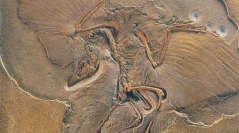

 Comptes Rendus Palevol
3 (2) - Pages 99-118
Comptes Rendus Palevol
3 (2) - Pages 99-118The feathers of Archaeopteryx have been known for over 140 years, are the most important reason for its fame and avian status. Previous analyses have almost unanimously focused on the remiges and rectrices. Faint remains of what appears to be body contour feathers are, however, present in the Berlin specimen along the back, around the legs, and possibly anterior to the basal part of the neck. Although noted by numerous previous authors every reference to these feathers was anecdotal. Recent claims that body feathers were once present but were mechanically removed appear unsubstantiated. Rather, the Berlin Archaeopteryx has to this day the same regions more or less intact as depicted on early drawings. The present study reveals that the impressions are very different from preparation scratches, and are consistent with body feathers. The counterslab corroborates this, and in several cases both raches and barbs can be made out. The preserved body feathers of the back and the legs evidently were considerably smaller than the flight feathers, and clearly pennaceous in nature. The state of preservation does not, however, permit secure inferences that these body feathers necessarily resembled body contour feathers on most extant volant birds, nor that such feathers were distributed all over the body, although this is one possible scenario. Alternatively, the feathers on the back and legs could have resembled more simple contour feathers with open vanes, present in, for instance, ratites. Faint impressions at the base of the neck may even represent ‘hair-like proto-feathers’, and if so have been generated from some sort of ‘proto-apteria’, whereas the longer feathers with vanes on back and legs grew from ‘proto-pterylae’, corresponding to those areas with the longest neoptiles (embryonic downs), the first feathers to appear in embryos of several modern birds.